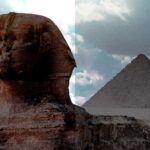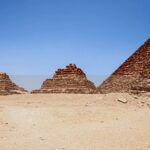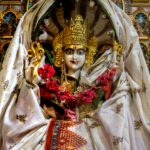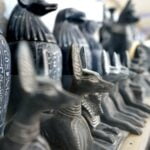Are you ready to embark on a journey through the annals of ancient mythology, where gods and goddesses wield their powers and shape the destiny of humankind? In this article, we delve deep into the enigmatic myth of Isis and Osiris, peeling back the layers of symbolism to uncover the profound significance it holds within the tapestry of human history. As we navigate the realms of ancient civilizations and unravel the timeless tale of love, betrayal, resurrection, and ultimate transformation, prepare to be mesmerized by the enduring relevance of this captivating myth in our contemporary society.
The Myth of Isis and Osiris
As we delve into the captivating story of Isis and Osiris, we uncover a world of ancient Egyptian mythology and the profound significance it holds within human culture. This myth, which centers around the gods Osiris, Isis, and their son Horus, weaves together elements of creation, death, rebirth, and the enduring power of love.
The Ennead of Heliopolis: A Divine Ensemble
At the heart of the myth lies the Ennead of Heliopolis, a group of nine powerful Egyptian deities. Among them, Osiris and Isis assume central roles, representing key aspects of creation and the natural world. Osiris, the god of the sun, agriculture, and health, personifies the life-giving forces of nature. Isis, the daughter of Geb and the sky goddess, embodies the nurturing and protective qualities of the earth.
A Tale of Tragedy and Resurrection
The myth unfolds with the tragic demise of Osiris at the hands of his jealous brother, Seth. In a brutal act of violence, Seth tears Osiris apart and scatters his dismembered pieces throughout Egypt. Despite the agony of loss, Isis and her sister Nephthys embark on a quest to retrieve and bury Osiris’s scattered remains, with the exception of his phallus. Their unwavering love and devotion give rise to new life for Osiris in the underworld, where he assumes the role of a just ruler.
The Myth as a Creation Story
The myth of Isis and Osiris not only tells a tale of love and resurrection but also serves as a creation story in Egyptian mythology. It holds the key to understanding the origins of the world and the interconnectedness of life and death. Through the myth’s intricate symbolism and narrative richness, we gain insights into the intricate web of Egyptian cosmology and the profound questions humans have pondered since ancient times.
Enduring Influence and Legacy
Among the vast array of Egyptian myths, the tale of Isis and Osiris stands out as the most elaborate and influential. Its themes of love, death, and rebirth have resonated across cultures and time, leaving an indelible mark on human storytelling. From ancient Egyptian art and literature to contemporary adaptations, the myth’s enduring legacy reminds us of our shared humanity and the timeless power of mythological narratives.
“Through the intricate and poignant myth of Isis and Osiris, we gain a profound understanding of the human desire for eternal life, the transformative nature of love, and the timeless quest to unravel the mysteries of creation.”
In ancient Egypt, there are countless fascinating and mythical stories that continue to captivate our imaginations. From the powerful gods and goddesses to the epic adventures of pharaohs, these famous Egyptian myths hold a timeless allure. If you’re curious to delve deeper into this magical world, click here to explore some of the most intriguing tales of ancient Egypt. Let yourself be immersed in the rich tapestry of history and mythology, and discover the wonders that lie within these legendary stories. So, what are you waiting for? Embark on a journey through time and unravel the mysteries of the past with our collection of famous Egyptian myths. Just click on the following link: famous egyptian myths.
The Myth of Isis and Osiris: A Timeless Tale of Love and Loss
[youtube v=”drAT_4NQJG4″]
The Mythical Love Story Unveiled
In the ancient era of the Pharaohs, the world believed in the existence of powerful gods. Among them were Geb, the god of the earth, and Nut, the goddess of the heavens. Geb and Nut, from the divine realms, entered into a sacred union and bore four children. Of their offspring, two sons were named Osiris and Set, and two daughters were named Nephthys and Isis.
In this unique society, it was believed that brothers could marry their sisters. Consequently, Osiris and Isis became united in marriage, bringing immense happiness and love into their lives. Osiris, the king who effectively ruled the entire country, was adored by his people for his fairness and popularity.
However, their idyllic life of love and harmony was disrupted by the envy and rage of Osiris’ brother, Set. Consumed by his desire to rule, Set devised a sinister plan to eliminate his own brother and claim the throne for himself.
A Treacherous Scheme Unleashed
Set cunningly organized an extravagant party, inviting all the people of the land, including his brother Osiris. Amidst the revelries, Set unveiled a remarkable golden box, designed in an intricate manner. Pretending it to be a golden coffin, he declared that it would be bestowed upon anyone who perfectly matched its measurements.
To the astonishment of all, only Osiris possessed the exact dimensions to fit inside the coffin. Seizing this opportunity, Set swiftly enclosed Osiris within the coffin and callously cast it into the Nile River, assuming that he had forever rid himself of his brother.
A Love That Transcends Death
Devastated by the loss of her beloved husband, Isis embarked on a relentless quest to find his body. Her tireless search led her to finally discover Osiris’ remains. However, Set, driven by his malice, cruelly dismembered the body into forty-two pieces, scattering them across various locations throughout Egypt.
Undeterred by the daunting task ahead, Isis resolved to retrieve and reunite Osiris’ fragmented body. She appealed to Anubis, the god of embalming and the dead, to assist her in this Herculean feat. Together, they painstakingly collected each piece, slowly and lovingly restoring Osiris to life.
Regrettably, their reunion was short-lived, as death claimed Osiris once more. He journeyed to the underworld, becoming its divine ruler. Devoted to protecting their son, Horus, from Set’s harm, Isis painstakingly raised him, preparing him for the day when he would avenge his father’s death and ascend to the throne as the ruler of Egypt.
An Eternal Legacy
The myth of Isis and Osiris, the first love story in history, is a profound and enduring tale that delves into themes of creation, death, rebirth, and love. It revolves around the Ennead of Heliopolis, a group of nine powerful Egyptian deities, with Osiris and Isis playing central roles.
This tragic narrative showcases humanity’s yearning for eternal life, the transformative power of love, and the timeless pursuit of understanding the mysteries of creation. Through the centuries, it has captivated audiences across cultures, leaving an indelible mark on art, literature, and adaptations.
As we delve into the depths of this mythical tale, we unravel the origins of the world and witness the intricate interplay between life and death. Join us on this timeless journey of love, loss, and the eternal quest for meaning.
“The myth of Isis and Osiris resonates throughout history, echoing humanity’s deepest desires and immortalizing the power of love in all its forms.”
FAQ
Question: Who are Isis and Osiris in ancient Egyptian mythology?
Answer: Isis and Osiris are part of the Ennead of Heliopolis, a group of nine Egyptian deities. Osiris is the father of the god Horus, while Isis is the daughter of the earth god Geb and the sky goddess.
Question: What is the myth of Isis and Osiris?
Answer: The myth of Isis and Osiris is a central myth in ancient Egyptian belief. Osiris, the god of the sun, agriculture, and health, was slain by the god Seth, who tore apart his corpse and scattered the pieces all over Egypt. Isis and her sister Nephthys found and buried all the pieces, except the phallus, giving Osiris new life in the underworld as the ruler.
Question: Why is the myth of Isis and Osiris significant?
Answer: The story of Osiris, Isis, and Horus is considered the Egyptian myth of creation and is the most elaborate and influential of all Egyptian myths. It holds deep symbolic meaning and reveals insights into ancient Egyptian culture, religious beliefs, and the cycle of life, death, and rebirth.
Question: What was the role of Osiris in ancient Egyptian society?
Answer: Osiris was a significant deity in ancient Egyptian mythology and was associated with the sun, agriculture, and health. He played a crucial role in ensuring the fertility of the land and the well-being of the people. His death and resurrection symbolized the cyclical nature of life and the power of transformation.
Question: How does the myth of Isis and Osiris relate to contemporary society?
Answer: The myth of Isis and Osiris still holds relevance in contemporary society. It explores themes of love, loss, and the triumph of good over evil. By studying the myth, we gain insights into human nature, the search for immortality, and the power of hope and resurrection. The story’s enduring appeal demonstrates the timeless nature of these universal themes.
- Crypto Quotes’ Red Flags: Avoid Costly Mistakes - June 30, 2025
- Unlock Inspirational Crypto Quotes: Future Predictions - June 30, 2025
- Famous Bitcoin Quotes: A Deep Dive into Crypto’s History - June 30, 2025
















